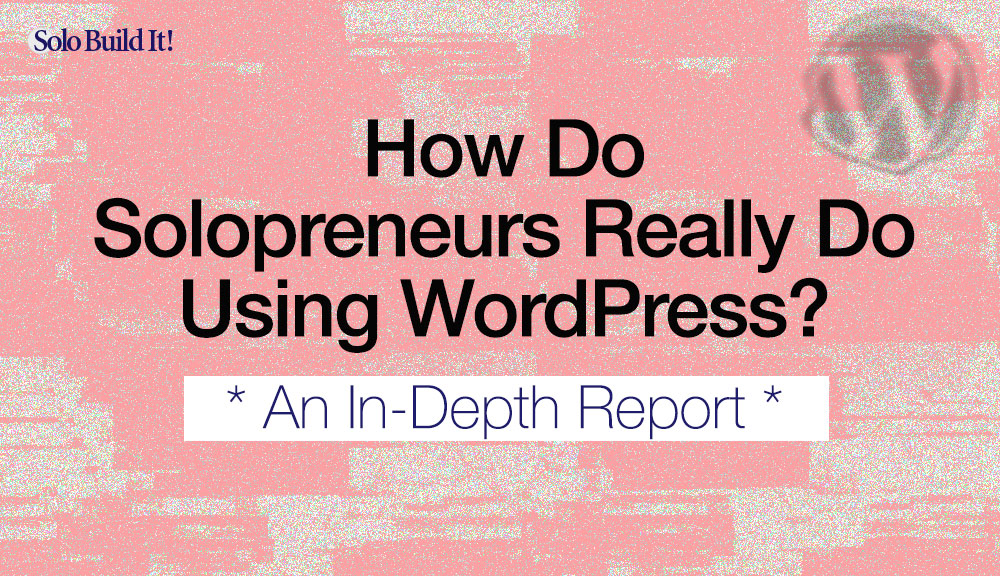
The biggest challenge today that solopreneurs — and really any small business owner faces — is the need to focus.
Neal Schaffer
Cut Through the Noise
There are roughly 3.3 million blog posts written every day.
Approximately 100 million hours of video are watched on Facebook every day.
And over 500 million tweets are sent every day.
A constant flow of emails, instant messages, notifications and other communications rounds out the info-glut picture. As a solopreneur, this avalanche of “choose me” hype makes it near-impossible to identify the platform that goes beyond hosting and sitebuilding.
It’s not about the tools, it’s about success. How do you know what to read or listen to? What advice should you heed, and what should you ignore? Most importantly, which service delivers your best chance at success?
That’s a big part of what our friend Neal Schaffer is referring to. He goes on to say that, “you are constantly bombarded with information that might not be relevant for you to run a successful business, and therefore it is easy to lose focus on the final objective.”
The “final objective” is, of course, your business success. Your decision could lead to a rewarding, online business, OR pull you down to wasted time, energy and money (all of which are in short supply for the average solopreneur)!
This brings us to the point of this study, the fourth of its kind. Previously, these “State of Solopreneurship” studies have performed rigorous, science-quality studies to determine the levels of solopreneur success at Wealthy Affiliate, GoDaddy and Wix vs. Solo Build It! (SBI!).
We compared and studied the best blogging platforms based on success rate.
Clearly, where you build your online business matters. That raises the obvious question…
Why? What’s different about SBI!?
Every company markets itself as being the best. Wix builds “stunning websites” while GoDaddy sells reliable hosting and tools. None, though, talk about their success rates. But what percentage of their customers actually succeed?
These first-of-a-kind studies not only reveal the numbers that matter. They give you the exact methodology to empower you to repeat the studies for yourself (just in case you don’t believe them)!
Why stop there?
Widening The Solopreneur Profile
After seeing how much better Solo Build It! solopreneurs perform, compared to users of Wealthy Affiliate, GoDaddy and Wix, we decided to test another approach, the most widely used one… WordPress.
New to WordPress? Read our article “What Is WordPress” first.
As we conducted these studies, we realized that we were actually building a profile of how well (or how badly, as it turns out) most solopreneurs are doing. Each of these platforms markets to solopreneurs differently…
- Wealthy Affiliate uses thousands affiliates to create fake reviews against competitors such as SBI!. The goal is to rank some of them highly enough to mislead. This was the impetus for doing a direct head-to-head study. The results surprised even us.
- GoDaddy is a typical web host, mostly focused on solopreneurs. They also provide a site builder and other tools, along with articles. It lacks, however, a dedicated focus on a winning process. While this type of provider tends to attract more sophisticated users, SBI! significantly outperformed it, too.
- Wix tends to attract less sophisticated solopreneurs, marketing itself a sitebuilding tool that builds “stunning” websites. The comparison study with SBI! shows that the typical solopreneur needs much more than just a stunning site.
Each of the three studies compares SBI! to a product that represents a typical example of the major approaches used to attract solopreneurs
- Wealthy Affiliate (a high-profile example of the “make money online” ilk). This category is loaded with false information from thousands of affiliates – WA pushes this beyond moral limits with false reviews of competing products.
- GoDaddy (web hosting). This category typically also offers an optional sitebuilder, other tools, lots of articles and the use of regular FTP, scripting, etc.
- Wix (sitebuilders). The marketing emphasis here is on the sitebuilder that builds beautiful sites. Hosting is included.
WordPress, the most used product, adds tens of millions of solopreneurs. This study gives us a view of the most commonly used approach of all, widening the solopreneur profile even further.
This study answers how well WordPress (WP) users do. Its approach is different from the first three…
- This popular blogging/sitebuilding software is free, highly regarded and extremely flexible thanks to the massive ecosystem of template and plugin vendors.
- Users purchase regular hosting (or the more expensive “Managed WordPress Hosting”). While WordPress does offer free hosting, you really do need your own domain and hosting to be considered seriously by search engines.
An extremely popular option, WP’s major disadvantage is the long learning curve for the software and the thousands of templates, plugins, etc. It tends to attract more sophisticated users, so we would not be surprised to see this study generate the best results yet.
However, the #1 problem for most WP-using solopreneurs is the lack of focus on a winning process. This, along with no training and little support, could compromise its success results. Interesting!
This study analyzes exactly how well solopreneurs do with WordPress. And, at the same time, it widens our picture of solopreneur results.
Important: Like the previous studies, this one also outlines the methodology in so much detail that anyone can perform the study to check the accuracy of the results. We have discussed at length why this is so important, but in a nutshell it’s this…
Companies that market products to solopreneurs reveal everything but their success rates. Success, though, is the only outcome that matters to the solopreneur. While SBI! has long demonstrated and proven SBI!’s high rate of online business success, no one else has.
And now, these studies go one big step further. They are the first to provide head-to-head success rates and levels.
Given the amount of over-hyped and unproven claims in this space, solopreneurs should insist upon objective, rigorous and reproducible studies that reveal actual success rates.
Let’s get right into the methodology and results specific to this study.
How Do WordPress Users Perform?
As mentioned, this series of studies cuts through all marketing claims and gets straight to the bottom line: success rates and levels. You get an unbiased look at how often, and how high, each platform performs.
Who Uses WordPress?
WordPress powers close to 30% of the websites on the Internet. You can choose to either host at WordPress.com (free) or install WordPress under your own domain, with a dedicated web hosting service.
That means WordPress is both a free platform and a website builder. Those who choose “free,” though, get very little traffic. Think about it – when was the last time you found a site hosted on WordPress? The answer is near-zero. This fact impacts the structure of this study…
For this to be a fair, apples-to-apples comparison, we exclude all sites hosted for free by WordPress (the weakest). Otherwise, the results would be highly lopsided (in favor of SBI!).
Serious solopreneurs don’t use free hosting. Therefore, for the purpose of this study, we only include those who choose their own domain name and install WP on a (paid) web host (e.g., GoDaddy, 1&1, HostGator, etc.).
This constraint is favorable to WordPress because many beginners start with the free WP option. SBI! owners range from raw beginners to sophisticated individuals who have yet to succeed online. So one of the questions that this study will answer is the following…
Does SBI’s approach overcome the higher level of sophistication and the highly touted flexibility of WP?
WordPress starts, too, with a second advantage…
Large Businesses on WordPress
While SBI! members (SBIers) are 100% solopreneurs, WordPress has many larger customers. So we should expect another bias in favor of WordPress – larger businesses, overall, have the resources and built-in reputation to build more traffic.
They also have the resources to build traffic using pay per click (PPC) advertising to sell products. Few SBIers buy ads, because they build so much traffic organically. This also tends to favor WordPress sites.
We chose to accept these WordPress-favoring biases, too, in order to keep the study simple. Overall, though note that, WordPress starts with some “built-in” traffic advantage due to solopreneur sophistication and the presence of larger companies (with their greater resources).
The study asks 2 questions:
- How successful are solopreneurs who use WordPress as their website builder? The answer will help round out the typical solopreneur experience, too.
- How do these results compare to the suite of services included within Solo Build It! (process and training, domain name registration, hosting, website builder, ongoing education and auto-updating, tools, community)?
Let’s proceed to the study, its data, then the analysis.
WordPress Data and Analysis
BuiltWith.com lists 23 million domain names for sites that are built with WordPress. Its detection process most likely misses some of the most invisible sites, yet another advantage for WP.
The study randomly selects 10,000 sites from this universe of WP sites. As we have seen in the GoDaddy and Wix studies, 10,000 is a sufficient sample size to deliver statistically significant results. In other words, the 10,000 sites are a fair representation of all WordPress-built sites.
To keep this study “apples-to-apples,” the process needed to do even more filtering to achieve “apples-to-apples” comparison…
- Eliminate parked domain names, sites “under construction,” sites that have no content, etc. SBI! has few of these types of sites, so their elimination yields a fair comparison. A final constraint…
- Selected sites also had to have a home page and at least five links to internal pages on the same domain name. The study’s random selection process used these criteria to choose 10,000 “ Real Effort ” sites.
We use the term Real Effort to designate websites that have a certain level of site-building effort. Filtering out “non-effort” sites yielded the first surprising result…
We had to parse through 24,000 WP domain names, just to find 10,000 Real Effort WP-built, hosted websites. Only 41% of WordPress websites fulfill the Real Effort definition.
As a comparison, GoDaddy and Wix were at 5% vs. SBI!’s 10,000 Real Effort site percentage of 92%.
Conclusion so far?
WP users seem more serious and sophisticated than GoDaddy and Wix users. But Solo Build It! members still get started more effectively, likely due to the clear, step-by-step Action Guide.
They advance through the early steps significantly better. While there are more conclusions to come, it’s hard to underestimate the importance of this finding…
Effective early progress is one of the most important online success factors.
You have to fine tune your ideas and focus in order to make everything work. You can’t do everything and be everything all at once.
Peg Fitzpatrick
We conducted a manual review of 500 randomly selected Real Effort WordPress websites (out of the 10,000) to double-check whether this filter had selected similar populations for comparison.
The review confirmed that. It showed this distribution:
- 442 solopreneur content sites (blogs, infopreneurs, etc.)
- 30 service sites (lawyers, dentists, service sellers, etc.)
- 8 local sites (local restaurants, schools, etc.)
- 7 online stores (small to medium retailers)
- 7 junk sites (sites with poor content / no real effort)
- 6 brochure sites (company sites with products/services)
The Real Effort criterion successfully narrowed the study’s focus to legitimate, business-oriented, solopreneur-built websites. Some exceeded “solopreneur” size and scope (i.e., larger companies), but we accept that and other skews in favor of WordPress in order to keep the study simple and reproducible.
Armed with a sufficient “apples-to-apples” sample of active websites from WordPress, we were ready to compare them against online businesses built by solopreneurs using Solo Build It!.
WordPress vs. Solo Build It! — The Results
We’ll review how WordPress and Solo Build It! Real Effort websites performed for each of the three traffic metric tools. First, we summarize the overall results:
-
SBI! websites are 9 times (9X) more likely to achieve “Outstanding – Excellent” levels of traffic than WordPress.
“Outstanding – Excellent” is defined as being among the top 1,000,000 sites on the Internet (<1M at Alexa, SimilarWeb, SEMrush).
-
SBI! websites are 3.6 times (3.6X) more likely to achieve “Medium” levels of traffic than WordPress.
“Medium” level of traffic is defined as websites having traffic that places them among the top one million to ten million websites (1M – 10M at Alexa and SimilarWeb).
-
76.4% of WordPress Real Effort websites are Invisible. Solo Build It!’s “Invisible” rate is only 40%.
“Poor to Invisible” is the lowest traffic category. WordPress nearly doubles Solo Build It!’s lowest traffic range (called “Invisible,” these sites get no detectable traffic).
These results are the averages of all three tools.
Now let’s break down the results of the 10,000 Real Effort WordPress websites versus Solo Build It! websites.
Results – Alexa
First, let’s look across the entire range of website traffic according to Alexa. Alexa ranking ranges appear on the Y-axis and the % of sites in each of those ranges on the X-axis.
The bars on the chart below indicate, of the combined total number of websites that fall within each range, what percentage are WordPress (red) and what percentage are Solo Build It! (blue).
Note: The lowest Alexa numbers (rankings) have the highest traffic. For example, #1 (Google.com) has the most traffic, so would be included in the 1 to 100K range. Traffic decreases as we move down the graph from the top (i.e., increasing Alexa ranking reflects decreasing traffic).
A clear pattern emerges in the highest traffic category (1-to-1,000,000). SBI! massively outperforms WordPress at each of the 10 ranges. For example, within the best possible Alexa range, 1 – 100K, there are 23 Solo Build It! websites and only 9 WordPress websites — 72% SBI! (23/32) and 28% WordPress (9/32).
This continues until we reach the Alexa ranking range of 1M – 2M (the higher traffic end of “Medium”). From 1M – 2M until 9M – 10M (“Medium” ranges), SBI! continues to outperform. The gap narrows at a fairly steady rate along these ranges until we reach the “Poor to Invisible” ranges.
As we approach “Poor to Invisible,” the gap narrows, with the percentage of low-traffic SBI! sites decreasing rapidly, while increasing with WordPress.
Next, let’s use bar charts to look at the total number of sites that fall within each of the three major categories of traffic (Outstanding – Excellent, Medium, Poor to Invisible).
Count of websites vs. Alexa Traffic rank of 1 – 1M “Outstanding – Excellent”
Count of websites vs. Alexa Traffic rank of 1M – 10M “Medium”
An interesting pattern appears here. The ratio of SBI! to WordPress effectiveness is highest at 1-2M (the highest “Medium” range), leveling out at the lower levels of 7-10M. The consistency is striking, with an obvious conclusion…
The SBIer has higher odds of success, and those ratios are highest for the best results. The difference narrows until we reach poor results, which is where the majority of WordPress sites reside.
We can see the continuation of this pattern in the “Poor to Invisible” ranges, where WordPress surpasses SBI! in delivering poor results. The worse the result, the more WordPress “dominates,” as shown here:
Count of websites vs. Alexa Traffic rank of 10M – 20M+ “Poor to Invisible”
Results – SimilarWeb
Here’s how the spectrum of websites ranks according to SimilarWeb:
Like Alexa, SimilarWeb ranking starts with #1 at the top and goes “down” from there. As you move down the chart, the SimilarWeb rank increases, reflecting sites that get less and less traffic.
The bars on the chart indicate, of the combined total number of websites that fall within each range, what percentage are WordPress and what percentage are Solo Build It!.
For example, within the best possible SimilarWeb range, 0 – 100K, we found 18 Solo Build It! websites and 5 WordPress websites that fit our criterion for Real Effort. That equates to 78% Solo Build It! (18 websites out of 23 total) and 22% WordPress (5 out of 23).
Next, let’s look at the total number of sites that fall within each of the three major categories of traffic (Outstanding – Excellent, Medium, Poor – Invisible).
Important: Note the identical patterns in the SimilarWeb and Alexa results, a strong confirmation because the two metrics systems generate their numbers differently.
Count of websites vs. SimilarWeb Traffic rank of 1 – 1M “Outstanding – Excellent”
This is comparable to the Alexa multiple. While the overall chart results ramp up for SBI! sites, it remains relatively flat for WordPress sites. Only Solo Build It! delivers this level of results at this rate.
Count of websites vs. SimilarWeb Traffic rank of 1M – 10M “Medium”
Count of websites vs. SimilarWeb Traffic rank of 10M – 30M+ “Poor to Invisible”
Results – SEMrush
Finally, here’s how the spectrum of websites ranks according to SEMrush:
SEMrush presents absolute traffic counts, not “traffic ranking” (as Alexa and SimilarWeb do). So 0 means no organic search traffic.
Note, too, that these results are specifically search traffic. Search accounts for most of the traffic of most solopreneur sites. Analyzing this backbone gives us a clean look at the backbone, search traffic.
The bars on the chart indicate, of the combined total number of websites that fall within each range, what percentage are WordPress and what percentage are Solo Build It!.
For example, within one of the highest possible SEMrush ranges, 90K – 100K, we found 27 Solo Build It! websites and 2 WordPress websites that fit our criterion for Real Effort. That equates to 93% Solo Build It! (27 websites out of 29 total) and 7% WordPress (2 out of 29).
You can see how SBI! (blue) dominates at the high-traffic portion of the chart while WordPress (red) takes an increasingly large share as traffic decreases.
Note: In the SEMrush bar charts below, traffic increases as you move down, reflecting more and more traffic from search engines.
Note: In our Wealthy Affiliate study, we performed an analysis that correlated SEMrush organic search traffic numbers to Alexa’s and SimilarWeb’s traffic ranking…
- SEMrush traffic of greater than 5,000 was the equivalent of being in the Top 1M sites (“Outstanding to Excellent”)
- 100-5,000 was equivalent to “Medium” (1M – 10M)
- 0-100 was equivalent to “Poor to Invisible.” (>10M).
We don’t chart these here, but search traffic correlates well with the total traffic of Alexa and SimilarWeb. In fact, the above chart shows the same patterns described in the overall Alexa graph at the change from Top 1M – 2M to 10M and with a sudden burst in percentage of WordPress sites at 0 (no search traffic).
Next, let’s look at the total number of sites that fall within each of the three major categories of traffic (Outstanding – Excellent, Medium, Poor to Invisible).
Count of websites vs. SEMrush Organic Traffic of 5K – 400K+ “ Outstanding – Excellent”
Count of websites vs. SEMrush Organic Traffic of 100 – 5K “Medium”
Count of websites vs. SEMrush Organic Traffic of 0 – 100 “Invisible to Poor”
The big picture conclusion here is that SBI! Is particularly effective at driving search traffic, the best traffic of all because it is free, it is targeted, it sustains and it constantly delivers new visitors to you.
Final Analysis
Now that we’ve taken a deep dive into the data, let’s come back up for some air. The data (averages of all 3 traffic metrics) shows, in a few different ways, that online businesses started with Solo Build It! get more traffic than those built with WordPress.
Let’s revisit the conclusions (average of Alexa, SimilarWeb and SEMrush) that we shared earlier:
-
-
SBI! websites are 9 times (9X) more likely to achieve “Outstanding – Excellent” levels of traffic than WordPress.
“Outstanding – Excellent” is defined as being among the top one million websites on the Internet (<1M at Alexa and SimilarWeb).
- SBI! websites are 3.6 times (3.6X) more likely to achieve “Medium” levels of traffic than WordPress.
-
SBI! websites are 9 times (9X) more likely to achieve “Outstanding – Excellent” levels of traffic than WordPress.
“Medium” level of traffic is defined as websites having traffic that places them among the top one million to ten million websites (1M – 10M at Alexa and SimilarWeb)
-
76.4% of WordPress Real Effort websites are Invisible. Solo Build It!’s “Invisible” rate is only 40%.
The “Poor to Invisible” is the lowest traffic category. WordPress “beats” Solo Build It! in the lowest traffic range within this category (called “Invisible,” these sites get no detectable traffic).
The first two conclusions are based upon the total number of Solo Build It! and WordPress sites within each range, averaged across all three traffic metric tools. You are 9X more likely to develop a high-traffic site with Solo Build it! than with WordPress, 3.6X for a medium-traffic
site.
If you look solely at SEMrush, Solo Build It! websites outpace WordPress sites by a whopping 17.16X! Why is this so important?
Organic search traffic is important to solopreneurs, who tend to be constrained by money (not just by time!).
Whether you monetize passively (where you really need high traffic to earn well) or actively…
More targeted traffic = more income = success.
Final Thoughts on the State of Solopreneurship
We continue to see substantial differences depending on which platform the solopreneur chooses to build her or his website. Once again, SBI! is the difference, and by a large margin, between likely failure vs. a solid chance of success.
SBI! is an all-in-one package of step-by-step process, software tools, comprehensive guidance, 24/7 support and “auto-updating” that enables solopreneurs to build profitable online businesses.
The Action Guide is the step-by-step guidance for executing SBI!’s core process. That process has evolved over 15 years but remains based on the concept of Content Traffic PREsell Monetization) (C T P M), automatically updated for significant new changes.
The beauty of C T P M is its simplicity and its evergreen nature. The core business concepts are universal to all businesses. They were valid 500 years ago and will remain valid during these fast changing times.
C T P M is so simple and flexible that it easily integrates major changes as the Internet evolves. Therefore, as search engines become more sophisticated, as the Internet continues to grow more complex, we expect the SBIer’s advantage to grow, not just due to the approach, but also because we constantly simplify and update what’s important.
It makes sense that a service like WordPress would pale in comparison. It offers some great tools and services, but none of the other essential aspects — in particular, the process and the guidance — that help Solo Build It! members achieve so much.
This helps SBIers save an enormous amount of “figure it out” time. Solopreneurs, by definition, have a limited amount of time to invest. They have no time to read extensively (to learn and keep up), for trial and error, nor to make mistakes.
Time is the solopreneur’s biggest enemy. SBI! optimizes its use, giving the SBIer a significant edge over other solopreneurs. Saving time enables SBIers to focus 100% on building their business.
We have also seen how SBI! is especially strong at growing search engine traffic. However,, we focus very little on the details of SEO, proving that it’s the process (and the deep understanding of it), not the tools, that accounts for the results.
This Study also shows, dramatically, that what a site looks like has very little impact on its success. Clearly, you need more than WordPress’s promise of infinite templates (for “a beautiful website”) if you want to build a real online business that generates traffic and revenue.
We’re thrilled with the success that so many of our customers achieve. Those numbers translate into real people. Read these real-life success stories to see what we mean.
It’s more important than ever to help everyday people cut through intense and contradictory noise so that they can focus their time and energy on what’s important — becoming extraordinary.
But what if you’re one of the tens of thousands of would-be solopreneurs who haven’t yet joined Solo Build It!? You have a critical decision to make.
Do you want to start a new online business? Have you been tempted by celebrities or Super Bowl commercials talking about how “it’s easy” to start a website?
It’s critical to remember this:
There’s a world of difference between the two.
You need more than a shiny site builder.
You need more than a promise to have your site up in 5 minutes.
You need more than detailed hosting specs and tool features. Benefits such as “unlimited domain names” are hype – one serious business is all that most people ever need or have time for. When solopreneurs succeed, they need to hire more people, not create more websites! And yes, we cover that topic, too.
Bottom Line? You need and deserve more than “being sold.”
You need to be able to see the real differences between platforms — data-supported results.
Who cares which one offers more domain names or storage space? Which one offers proven processes that are going to help you succeed?
You need to have access to real reviews and real proof from real people about a company’s track record of success.
Not more marketing hype and fake affiliate claims.
You need a business-building platform and a partner that’s going to do everything possible to help you save your most precious commodity…
Time.
We mentioned this earlier, but it’s worth exploring further…
Time is the ever-growing challenge facing solopreneurs today. Content Shock is simply another symptom, right alongside Social Media Overload and News Fatigue.
We bring you only the small number of important changes that will help grow your business. This ongoing auto-updating is critical…
Countless voices scream to snag some of your precious minutes. You cannot afford to waste time on anything less than the proven best.
If you’re serious about creating an online business based on your knowledge and passions, one that offers real opportunities for online business success…
- insist on verifiable proof like this
- check out more rigorous studies such as the head-to-head study vs. Wealthy Affiliate or Wix or GoDaddy
The State of Solopreneurship?
As we widen our studies to include more of the most common ways that solopreneurs choose to grow a business, a clear pattern of failure emerges. We don’t expect that to change until companies start to take your success more seriously than merely selling a product.
The head-to-head studies, when taken together, start to give us an estimate of how solopreneurs do in general. The answer is that the true status is poor, but the odds of success can be multiplied by 30-100X (and more) with SBI!.
The “solopreneur industry” creates a rosy picture that’s not supported by actual results. We hope that serious companies see this and pick up the pieces and dedicate themselves to truly helping you succeed.
If you insist, they will. If that happens, we’ll enter a new era for solopreneurs — one that fulfills the promise of the Internet.
Yes, that means we’ll see our first serious competition for Solo Build It!. We not only believe in solopreneurs and what they can achieve through online business success, we know that there’s lots of room for way more folks to succeed. In short…
We welcome anything that helps more solopreneurs take advantage of this unique time in history, when the individual can seize control of his/her life by starting a business with so little risk.
LET’S COMPARE!
Wix / GoDaddy / Wealthy Affiliate / WordPress / Squarespace vs. Solo Build It!
As we complete each study, it’s helpful to compare the results to all previous studies as there are new conclusions that can be reached.
For reference, here are the key charts:
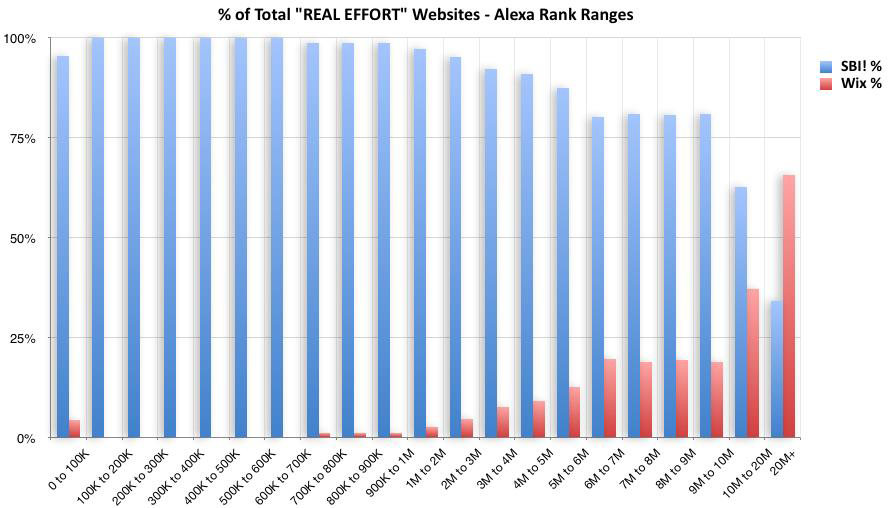
View the whole Wix Study.
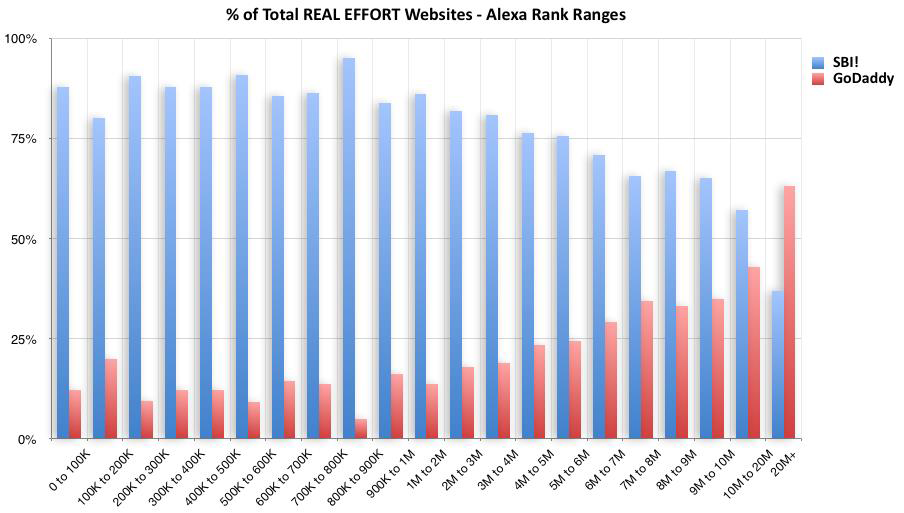
View the whole GoDaddy Study.
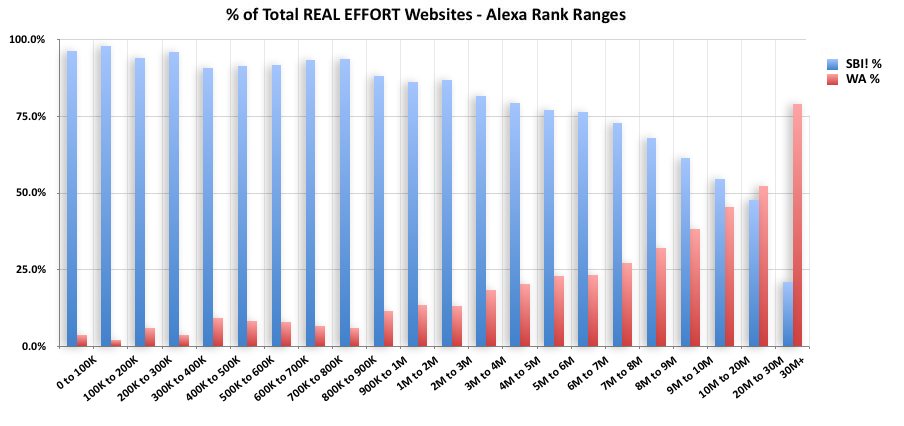
View the whole Wealthy Affiliate Study.

View the whole WordPress Study (you are here).

View the whole Squarespace Study.
These comparisons detail the percentage of each platform’s sites within the Alexa traffic ranges. The lower the Alexa traffic range, the higher is the website’s traffic.
Clearly, choosing Solo Build It! means that your chances of building a successful site that drives serious traffic are significantly higher than if you use Wix, GoDaddy, Wealthy Affiliate, WordPress or Squarespace.
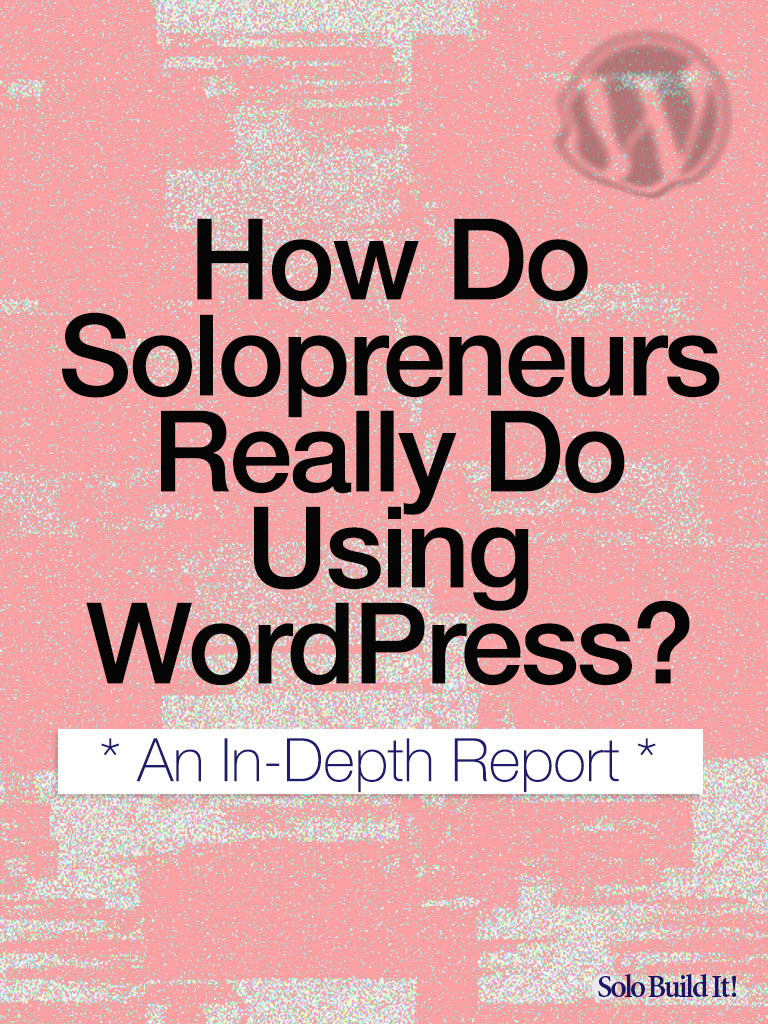

Latest posts by Mike Allton (see all)
- How to Avoid Failure in an Entrepreneurial Business - September 23, 2019
- How to Use Buffer for Social Media Management: The Solopreneur’s Guide - September 15, 2019
- Wix Review: An In-Depth Comparison of 10,000 Websites - September 1, 2019













